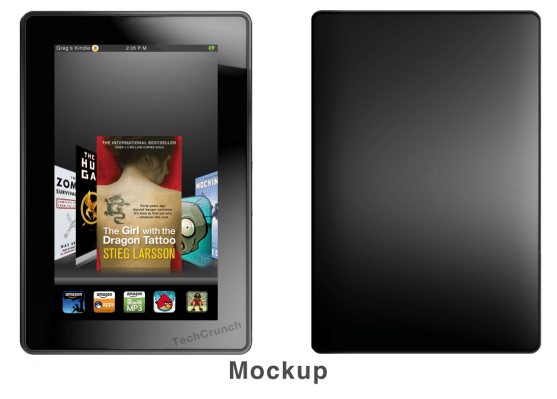The Amazon Kindle tablet is real. Very much real. As in, MG has held it in his very own hands. I threw together the mockup above based on what he shared with me.
As MG explained, we now know that the Kindle tablet won’t initially ship in both 7-inch and 10-inch variants, contrary to previous rumors. After a change in plans earlier this summer, Amazon only intends to launch with a 7-inch model.
That decision might just be the best one that Amazon could have possibly made — and it ought to have Samsung and all of the other Android tablet manufacturers shaking in their boots.
Before we dive in, we need to establish some numbers. So far this year, the iPad has maintained roughly 70-80% of the tablet marketshare. While certain Android tablets are undoubtedly more popular than others, that only leaves 20-30% of the market for all of the Android tablet manufacturers to split. While Apple sits with the biggest piece of the pie all to themselves, the Android tablet manufacturers are battling for left overs. Even if the entire Android tablet marketshare belonged to one tablet (which, again, it definitely does not), said tablet still wouldn’t have sold even half as well as the iPad.
From this, we’ve learned at least one thing: competing with the iPad by trying to be the iPad.. doesn’t really work.
Over the past few months, I’ve noticed something strange. Among my geekier circles, I’m always hearing the same question: iPad, or Xoom/Galaxy Tab/Android-tablet-name-here? Among less tech-minded folks (you know, like the majority of the population) though, the question seems to shift: iPad, or Kindle?
Now, it’s not that the less tech-savvy people wouldn’t like an Android tablet… they just don’t really seem to know they exist. There are just too many strikingly similar tablets, all battling for that one smaller sliver of the pie.
To go all anecdotal again here for a second: just this past Monday — as I do every Monday — I was playing trivia at a pub in the Bay Area. Trivia Night at this pub is something of a huge deal, with around 25 teams (4-6 people each) playing each week. Mid-way through the second round, the trivia master asked: “Two pointer here, folks: What is the name of Motorola’s tablet device? What is the name of Dell’s tablet?”
Three teams could name Dell’s tablet. Six teams got Motorola’s. Out of 25 teams, each made up of a handful of drinking-age adults, less than a third could conjure up the name of one of the biggest Android tablets around. Though we’ll gladly babble on it for days on end, the tablet market is still something of a niche — and in a niche market, recognition is everything. The iPad is the iPad. Everything else is.. well, everything else. If they were to launch with a 10″ tablet, Amazon would be throwing themselves in with everything else.
But they’re not. Rather than taking on Apple on their own court, they’re moving to keep a lock on a game they’re already kicking butt at (the e-reader market), while upping the odds that anyone weighing “iPad or Kindle?” will be swayed in their favor. By launching with a 7″ tablet (and only a 7″ tablet), Amazon is making it clear: they don’t want the Kindle tablet to be the iPad. They want it to be everything the iPad is not.
They want it to be small, and comfortable to read in bed. This is a Kindle, after all. For many folks who just want something to read in bed or throw into their bag to read on the train, the iPad’s nearly 10-inch display can feel a bit gigantic.
They want it to be cheap. Smaller displays are cheaper right up front, require less plastic for the body, and can get by with a lesser battery and a smaller backlight. More than a year after launch, the cheapest iPad you can buy new will set you back $499. According to the same source whose Kindle tablet we used, Amazon currently has it priced at half that: just $250. Even launching a 10-incher alongside would increase R&D costs, as well as lead consumers to believe that the 10″ model is the flagship (thereby throwing it up directly against the iPad and everything else.)
Meanwhile, they’re moving away from the direction that most other Android tablets have taken. This isn’t a be-all, do-all machine — it’s a new and improved Kindle, just as the name will imply. They’re aiming for simplicity, distilling the homescreen down to a Cover Flow-esque arrangement, making the entire experience all about your books, movies, and other media. And if you happen to want it to do other stuff? Sure, it can do that — they even have their very own App Store! But this isn’t an Android tablet. It’s a Kindle, and it just happens to run Android.
As for Samsung, LG, Motorola, and all the other tablet makers out there: unless they’re happy with whatever sliver of the minority chunk they’ve nabbed so far, they better take this as a shot right across the bow. For Android tablet manufacturers, the next big step will be figuring out how to ensure that the general consumer has any idea that their tablet exists — and here comes Amazon, swooping in with their cheap, small tablet and bringing the iconic, incredibly well-established Kindle brand (and their incredibly powerful distribution channel) with them. Genius.
